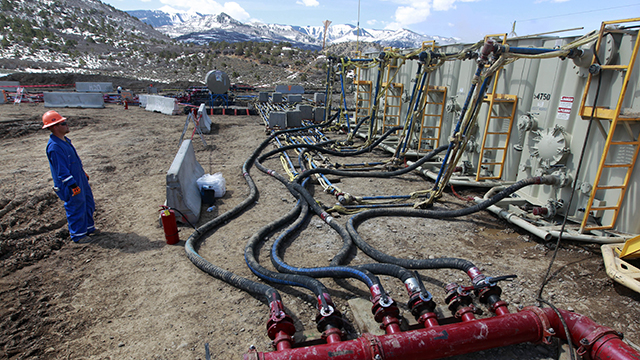
In this March 29, 2013 photo, a worker helps monitor water pumping pressure and temperature, at an Encana Oil & Gas (USA) Inc. hydraulic fracturing and extraction site, outside Rifle, in western Colorado. (AP Photo/Brennan Linsley)
Hydraulic fracturing or fracking — a method of extracting natural gas from underground shale formations — has become a contentious issue across America, especially in New York, Pennsylvania, West Virginia and Ohio, states that sit on top of the Marcellus Shale, the largest known deposit of shale gas in America. Some estimate that the shale formation could contain nearly 500 trillion cubic feet of gas — enough to power all American homes for 50 years. Oil and mining companies want to get the gas out, but environmentalist groups say the process is not safe. Here are the facts:
What is fracking, and how is it used?
Hydraulic fracturing is a 60-year-old technology. In the 1940s, oil and gas companies learned that pressurized water, sand and chemicals could be injected into a shale formation to loosen the shale and release gas and oil. The chemicals dissolve minerals and kill bacteria, and the sand props open the fractures in the shale so the gas or oil can be released. In the 1990s, oil engineers in Texas began combining fracking techniques with horizontal drilling, using higher volumes of pressurized water and chemical cocktails to release natural gas trapped in shale formations that hadn’t been reachable through vertical drilling.
What are the benefits of fracking?
In the past decade, the use of fracking has transformed America’s energy industry. In 2000, shale gas made up one percent of America’s gas supplies; in 2011 it was 25 percent. Natural gas is cleaner than America’s other two primary sources of energy, coal and oil, and, while more expensive than coal, is far cheaper than oil.
The shale boom has also helped regions that are suffering economically, adding an estimated 72,000 new hires in Pennsylvania between 2009 and 2011.
What are the risks of fracking?
The chemicals that are injected into shale deposits during fracking in the U.S. include acids, detergents and poisons that can be harmful if they seep into drinking water. Trucking and storage accidents have caused spills of fracking fluids and the salty water used — called brine — also resulting in contaminated drinking water. Gas companies often do not disclose the composition of their fracking chemical cocktails, making it difficult to monitor the risks of each fracking project. Methane gas can also escape during fracking, creating the possibility of dangerous explosions.
After the fracking process, deposits of radioactive elements and huge concentrations of salt are left in the earth’s surface; in order to dispose of these deposits gas companies inject them into deep wells, in some cases triggering small earthquakes, as has already happened in eight U.S. locations. New Pennsylvania regulations enacted in 2011 require gas companies to recycle 90 percent of the briny water by reusing it to frack more shale.
Fracking allows us to burn what was until recently an unreachable fossil fuel reservoir, which leads to the release of more carbon dioxide into the atmosphere. In addition to the natural gas itself, both the methane gas that is a byproduct of extraction and the carbon dioxide that is created through burning that methane are greenhouse gases and contribute to global warming.
The New York State debate
Of the states over the Marcellus Shale formation, fracking is already underway in Ohio, Pennsylvania and West Virginia. Fracking is also being used to reach gas in states beyond the Marcellus deposit, notably North Dakota and Texas. But New York state policymakers have not yet decided whether fracking should be allowed in their state.
In September 2011, the New York State Department of Environmental Conservation released its recommendations for how the state can allow fracking without endangering New Yorkers with contaminated drinking water. The DEC recommended that fracking not take place within 2,000 feet of public drinking supplies or within 500 feet of private wells, unless approved of by the landowner. The proposed rules would also ban fracking within the New York City and Syracuse watersheds. In March 2013, the Democrat-dominated State Assembly approved a two-year moratorium on fracking from the state’s southern border with Pennsylvania to the Catskills until there is “conclusive scientific evidence” on possible health and environmental risks. Conventional drilling, which uses shallower wells and far less water than high-volume fracking, has gone on for decades in New York.
Outside the U.S.
The practice is controversial outside of America as well. France and Bulgaria have the largest shale reserves in Europe; France banned fracking in 2001 due to environmental concerns, and Bulgaria banned it in 2012. Environmentalists are looking for similar bans in England and Poland.

